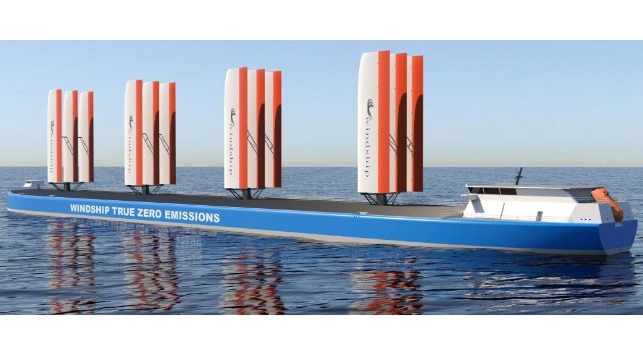Three-Wing Rig Design for Wind Propulsion Receives AiP from DNV

Classification society DNV issued an Approval in Principle (AiP) for a unique, three-wing rig designed to provide wind propulsion to large ocean-going ships. According to UK-based Windship Technology, the patented design can produce the power required to sail an 80,000 dwt ship on the main long transoceanic routes.
The unique rig design was developed using computational fluid dynamics (CFD) to refine the wings followed by extensive wind tunnel testing. Each rig consists of a three-wing foil set standing approximately 115 to 150 feet (35 to 45 meters) in height, depending on the size of the ship. Each wing has trailing edge flaps that allow for optimization of the motive force produced for a variety of incident wind angles and, according to the company’s analysis allow the rigs to produce the highest power density of any current wind-powered solution.
The wings would be deployed on vessels located on a steel cruciform base, which provides the intersection with the ship and also houses a lifting and lowering mechanism for the rig. To facilitate port access and bridge height clearance, the rigs can be lowered either fore and aft or over the ship’s side as required for loading and unloading operations. When the vessel is underway, the rigs are automatically controlled, rotating to gain the greatest motive advantage from the available wind power.

Close-up of the rig mounted on the deck of the vessel (Windship Technologies)
Windship Technology’s design includes the rigs as part of an overall solution for zero emission shipping. The design starts with the rigs, constructed from composite materials to reduce weight at height, and incorporates a diesel-electric drive featuring a full carbon capture system that reduces fossil fuel consumption while eliminating NOx, SOx, and particulate matter and zero CO2 emissions.
DNV applied verified models and data, based on our long-standing and globally accepted rules, in the review of the technology before issuing the AiP. After the approval from DNV, Graham Harvey, Chief Executive of Windship Technology said the company is now in a position to continue the multiple discussions it has been having with owners and charterers who are all looking for long-term solutions.
Speaking about the classification, Simon Rogers, Technical Director at Windship Technology said, “Fleet owners and charterers have a zero emissions option with Windship Technology’s whole-ship design that is set to revolutionize the industry. With the Energy Efficiency Existing Ship Index coming into force on January 1, 2023, the clock is ticking on the shipping industry. We welcome the Approval in Principle from DNV whom we have worked with in achieving this classification.”
